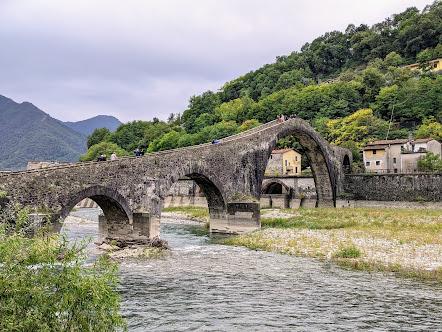
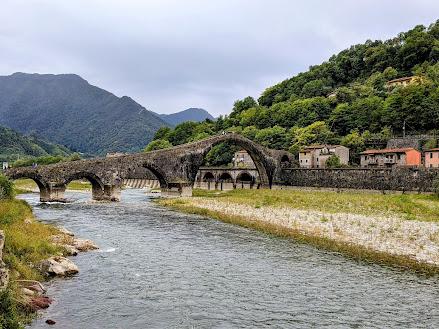
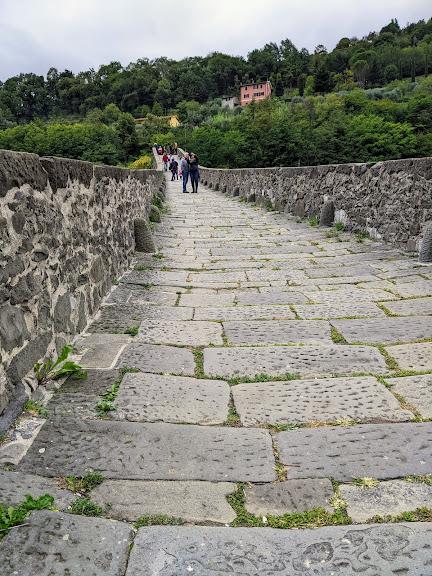
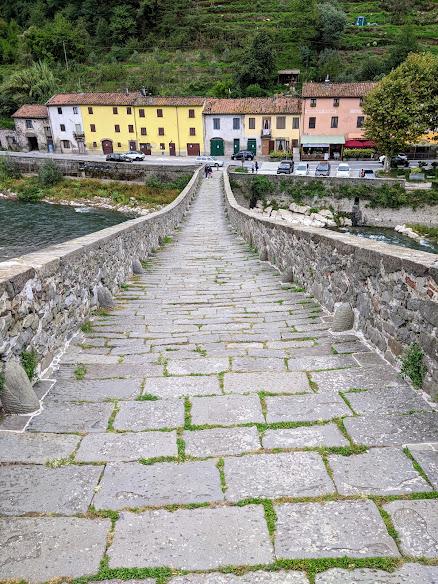
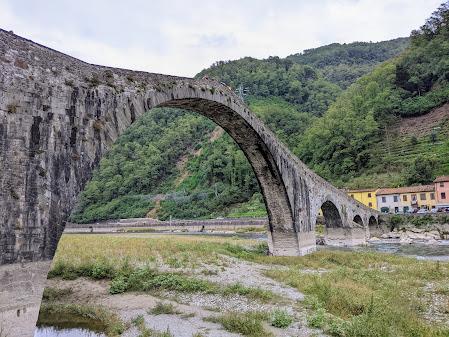

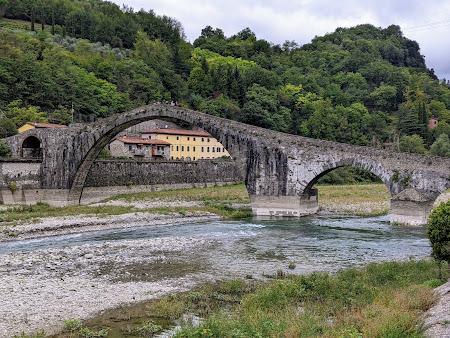
Photos /picture @ Luc-Henri Roger
Le Pont de la Maddalena, connu sous le nom de Pont du diable, est l'une des constructions les plus originales de toute la Toscane et se trouve à Borgo a Mozzano, entre Lucques et la Garfagnana. [Texte français après le texte anglais]
[EN] THE BRIDGE OF MARY MAGDALENE ALSO KNOWN AS THE DEVIL'S BRIDGE
The bridge was probably erected by Countess Matilda of Canossa in the eleventh century to allow travellers and pilgrims to reach Lucca and the Francigena. It was restored by the government of Castruccio Castracani in the late thirteenth and early fourteenth centuries. The name of the bridge comes from the hermitage that was built at its foot in 1526, which contained a statue of Mary Magdalene. The statue can currently be found in the Church of Saint James the Great (San Jacopo) in Borgo a Mozzano. A masterpiece of medieval engineering, the Devil's Bridge overlooks the River Serchio and has always been the subject of fantasies, myths and legends. In the late 1800s, the bridge was modified to allow the passage of the Lucca-Aulla railway line, with the addition of a new are on the right bank. During the Second World War it was damaged by the Nazis, who were by then abandoning the fortifications of the Gothic Line, but fortunately the bridge was not destroyed. Although nobody knows for sure why the Devil's Bridge was spared by the Germans, it was likely because they deemed it not suitable for the transportation of military equipment and therefore not worth destroying. The bridge has the classic medieval "hunchback" design, but what makes it different is that the arches are asymmetrical and the central one is so high and wide that it seems to defy the laws of gravity.
THE LEGEND
The Legend: The sinister name of the "Devil's Bridge" is due to a legend of which there are several versions. The best known is the one that takes us back to its construction: it is said that the task of building the bridge was entrusted to Saint Giuliano l'Ospitaliere. The work proved difficult from the outset. The foreman in charge of the work was in despair because he knew that the bridge could not be completed in time. One evening, as he sat alone on the river bank, thinking of the disgrace he would be in if the bridge was not finished, the Devil appeared to him and proposed a deal. The Devil could make it so that the bridge was completed in a single night, but on one condition: that he could take for himself the first soul to cross the bridge. The pact was signed and in one night the Devil lifted the entire bridge into place with his pitchfork. Filled with remorse, the man confessed the deal to a priest, who told him to respect the pact but to send a pig over the bridge first. The next day the foreman prevented people from crossing the bridge and sent the animal over instead. Legend has it that the Devil, enraged by this insult, threw himself off the bridge into the Serchio and was never seen in the area again.
[FR] LE PONT DE MARIE MADELEINE AUSSI CONNU COMME PONT DU DIABLE
Le pont a probablement été érigé par la comtesse Matilda de Canossa au XIe siècle pour permettre aux voyageurs et aux pèlerins de rejoindre Lucques et la Francigena. Il fut restauré par le gouvernement de Castruccio Castracani à la fin du XIIIe siècle et au début du XIVe siècle. Le nom du pont provient de l'ermitage construit à son pied en 1526, qui contenait une statue de Marie-Madeleine. La statue se trouve actuellement dans l'église de Saint Jacques le Grand (San Jacopo) à Borgo a Mozzano. Chef-d'œuvre de l'ingénierie médiévale, le pont du Diable surplombe le fleuve Serchio et a toujours fait l'objet de fantasmes, de mythes et de légendes. À la fin des années 1800, le pont a été modifié pour permettre le passage de la ligne ferroviaire Lucques-Aulla, avec l'ajout d'une nouvelle arche sur la rive droite. Pendant la Seconde Guerre mondiale, il a été endommagé par les nazis, qui abandonnaient alors les fortifications de la ligne gothique, mais heureusement, le pont n'a pas été détruit. Bien que personne ne sache avec certitude pourquoi le pont du Diable a été épargné par les Allemands, il est probable qu'ils ont jugé qu'il ne convenait pas au transport de matériel militaire et qu'il ne valait donc pas la peine d'être détruit. Le pont a le design médiéval classique du "bossu", mais ce qui le rend différent, c'est que les arches sont asymétriques et que l'arche centrale est si haute et large qu'elle semble défier les lois de la gravité.
LA LÉGENDE
La légende : Le nom sinistre du "Pont du Diable" est dû à une légende dont il existe plusieurs versions. La plus connue est celle qui nous ramène à sa construction : on raconte que la tâche de construire le pont fut confiée à Saint Julien l'hospitalier. Le travail s'avéra difficile dès le début. Le contremaître en charge des travaux était désespéré car il savait que le pont ne pourrait pas être achevé à temps. Un soir, alors qu'il était assis seul sur la rive du fleuve, pensant à la disgrâce dans laquelle il tomberait si le pont n'était pas terminé, le Diable lui apparut et lui proposa un marché. Il lui annonça qu'il pouvait faire en sorte que le pont soit terminé en une seule nuit, mais à une condition : qu'il puisse s'emparer de la première âme qui traverserait le pont. Le pacte fut signé et, en une nuit, le Diable souleva le pont entier avec sa fourche. Rempli de remords, l'homme confessa le marché à un prêtre, qui lui dit de respecter le pacte mais d'envoyer d'abord un cochon sur le pont. Le lendemain, le contremaître empêcha les gens de traverser le pont et envoya l'animal à la place. La légende raconte que le diable, furieux de cette insulte, se jeta du pont dans le Serchio et qu'on ne le revit plus jamais dans la région.

